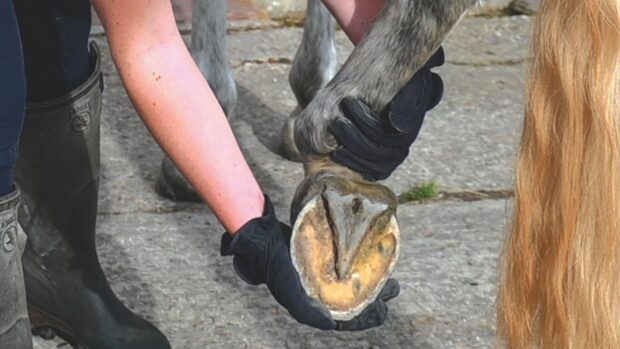Hard ground in the summer can be tough going for horses with thin or sensitive soles. We speak to two riders who have used gel hoof fillers as the solution
What is it, and who uses it?
SEVERAL top riders use gel hoof fillers to protect their horses’ feet.
Eventer and Riding Master of the Household Cavalry Richard Waygood uses hydroplastic hoof shields on several of his horses with thin or sensitive soles.
These come as packed granules that, when heated in boiling water, you can mould to the shape of the hooves without the need to remove the shoes. It quickly sets to form a hardwearing, resistant shield that should last as long as the horse’s shoes do, protecting him from stony or uneven ground.
World Single Horse Driving Trials Champion and registered farrier Paul Sidwell has tried a similar substance. This comes in a ready-mixed form and is applied with a “filler-gun”. It is applied to the sole of the foot, setting within 10min.
An advantage to using fillers is that, unlike plastic or leather pads, nothing can get underneath. However, it is important to make sure the horse’s feet are clean and free from any infection before application.
Why is it effective?
“ONE of my horses is really affected by the going and, even in walk, will appear unlevel on stony ground,” explains Capt Waygood. “But with hydroplastics in, the horse doesn’t seem to feel a thing. At some events, the going’s quite flinty, so knowing he isn’t going to struggle alleviates any worry I might have.”
For Paul Sidwell, it was his horse’s hooves that prompted him to try a gel filler.
“My horse, John, suffers from thin soles, so I tried a soft, rubbery filler that didn’t withstand the amount of work I was doing. I swapped to a firm-set filler that was more durable, although I did notice John’s stride was slightly shorter, suggesting that the filler may be putting some pressure on the sole.”
Can it be re-used?
IT depends which type you opt for. The filler Richard Waygood uses is reusable — he removes the lump of gel-like substance from the horse’s foot when it is shod, and puts it in hot water again to form a liquid that can be reapplied.
Is it expensive?
NOT according to Richard.
“It’s an affordable way of protecting the horse’s soles — one tub costs around £40,” he explains.
Paul’s version is slightly more expensive — a tube of filler costs around £20 and you need one tube per hoof.
How do I find out more?
FOR more information on available products, visit www.vettec.com or ask your farrier for advice.
This Q&A was first published in Horse & Hound (29 March, ’07)


